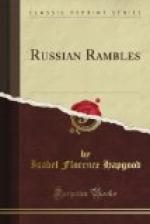This grand terrace of the Old Palace is a favorite resort for mothers and children, especially when the different bands of the Guards’ regiments stationed in the town furnish music. But not far away, in the less stately, more natural park surrounding the Alexander Palace, the property of the Crown Prince, lies the real paradise of the children of all classes. There is the playground, provided with gymnastic apparatus, laid out at the foot of a picturesque tower, one of the line of signal towers, now mostly demolished, which, before the introduction of the telegraph, flashed news from Warsaw to St. Petersburg in the then phenomenally short space of twenty-four hours. The children’s favorite amusement is the “net.” Sailors of the guard set up a full-rigged ship’s mast, surrounded, about two feet from the ground, by a wide sweep of close-meshed rope netting well tarred. Boys and girls of ambition climb the rigging, swing, and drop into the net. The little ones never weary of dancing about on its yielding surface. A stalwart, gentle giant of a sailor watches over the safety of the merrymakers, and warns, teaches, or helps them, if they wish it.
Their nurses, with pendent bosoms and fat shoulders peeping through the transparent muslin of their chemises, make a bouquet of colors, with their gay sarafani, their many-hued cashmere caps attached to pearl-embroidered, coronet-shaped kokoshniki, and terminating in ribbons which descend to their heels, and are outshone in color only by the motley assemblage of beads on their throats.
Here, round the gymnastic apparatus and the net, one is able for the first time to believe solidly in the existence of Russian children. In town, in the winter, one has doubted it, despite occasional coveys of boys in military greatcoats, book-knapsacks of sealskin strapped to their shoulders to keep their backs straight, and officer-like caps. The summer garb of the lads from the gymnasia and other institutes consists of thin, dark woolen material or of coarse gray linen, made in the blouse or Russian shirt form, which portraits of Count Lyeff Nikolaevitch Tolstoy, the author, have rendered familiar to foreigners. It must not be argued from this fact that Count Tolstoy set the fashion; far from it. It is the ordinary and sensible garment in common use, which he has adopted from others, not they from him. It can be seen on older students any day, even in winter, in the reading-room of the Imperial Public Library in St. Petersburg, on the imperial choir in the Winter Palace as undress uniform for week-day services, and elsewhere.
Some indulgent mothers make silk blouses for their sons, and embroider them with cross-stitch patterns in colored floss, as was the fashion a number of years ago, when a patriotic outburst of sentiment was expressed by the adoption of the “national costume,” for house wear, by adults of both sexes. From this period dates also, no doubt, that style of “peasant dress” which can be seen occasionally, in unfashionable summer resorts, on girls not of the highest class by any means, and which the city shops furnish in abundance as genuine to misguided foreigners. Every one is familiar with these fantastic combinations of colored lace insertion with bands of blue cotton worked in high colors, and fashioned into blouses and aprons such as no peasant maid ever wore or beheld.




